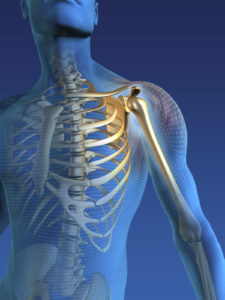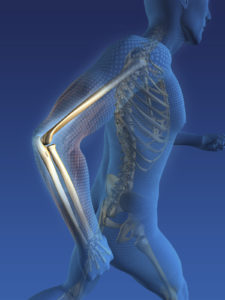Total Shoulder and Elbow Replacements
 Pain and discomfort in the upper extremity can prevent us from doing the things we love and seriously impact our quality of life. When conservative treatment methods fail to resolve the problem, total shoulder and elbow replacements may prove to be a viable alternative to relieve pain and restore normal functioning of the arm.
Pain and discomfort in the upper extremity can prevent us from doing the things we love and seriously impact our quality of life. When conservative treatment methods fail to resolve the problem, total shoulder and elbow replacements may prove to be a viable alternative to relieve pain and restore normal functioning of the arm.
Roughly 53,000 shoulder replacements are performed annually in the United States, with the number of patients who undergo elbow replacement surgery at around 3,000 per year. Although total shoulder and elbow arthroplasty are less commonly employed than knee or hip replacement, medical authorities assert that they are equally as effective in relieving joint pain. According to a recent study, the growth rates of shoulder and elbow arthroplasty were equal to or higher than those for total hip and knee replacements.
Shoulder and elbow replacement surgery are usually considered as the last line of defense and only adopted when more conservative treatments such as medication, injections, and physical therapy have failed to resolve pain and restore normal function. It is crucial for the patient to consult closely with their physician and healthcare support team when considering to undergo joint replacement surgery.
Shoulder replacement surgery was originally employed in the 1950s to treat severe shoulder fractures. Since then, total shoulder and elbow arthroplasty have become key tools in addressing many types of arthritis as well as degenerative joint disease that can impact the arm.
A variety of arthritic and degenerative conditions can damage the cartilage that supports and stabilizes the elbow and shoulder joints. These include:
- Osteoarthritis
- Rheumatoid arthritis
- Post-traumatic arthritis
- Rotator cuff tear arthropathy
- Severe fractures, and
- Failed previous shoulder or elbow replacement surgery
What is Total Shoulder Replacement?
 The shoulder is a ball-and-socket joint made up of the round end of the arm bone, a curved bowl-like surface (glenoid), cartilage, tendons, and ligaments. The shoulder allows the arm to lift, twist, and bend both forward and backward and gives it the greatest range of motion of any joint in the body. As the cartilage erodes and wears down over time, the bones can come into contact with each other, causing pain, discomfort, and stiffness.
The shoulder is a ball-and-socket joint made up of the round end of the arm bone, a curved bowl-like surface (glenoid), cartilage, tendons, and ligaments. The shoulder allows the arm to lift, twist, and bend both forward and backward and gives it the greatest range of motion of any joint in the body. As the cartilage erodes and wears down over time, the bones can come into contact with each other, causing pain, discomfort, and stiffness.
During the procedure, the surgeon removes the injured arthritic ball and replaces it with a metal rod placed inside the upper arm bone with a smooth metal ball at the end. The corroded socket (glenoid) is repolished and capped with a plastic or metal component.
Rehabilitation and physical therapy begin the day after surgery as the first few weeks following the procedure are crucial for restoring the mobility, strength, and normal functioning of the shoulder.
What is Total Elbow Replacement?

The elbow is a hinge joint consisting of the humerus (upper arm bone), the ulna (the outer forearm bone), and the radius (inner forearm bone).
Extensive damage or deterioration of the surfaces of the bones and cartilage of the elbow due to rheumatoid arthritis or trauma can cause severe pain and discomfort. In cases of extreme pain and joint degeneration, one’s doctor may recommend total elbow replacement surgery.
During the elbow replacement procedure, the surgeon will open a small incision at the back of the elbow to access the injured areas of the upper arm and forearm bones. Once scar tissue and spurs have been removed, artificial components consisting of a metallic plastic hinge and two metal stems will be placed inside the humerus and ulna bone cavities. A padded dressing will be used to protect the incision and close the wound as it heals.
As with total shoulder replacement surgery, rehabilitation and physical therapy are pivotal for the success of an elbow replacement. Gentle exercises are initially employed to control stiffness and inflammation. These are followed by range of motion and strengthening exercises as the wound heals. It may take up to six weeks following surgery to be able to perform routine tasks or to lift regular household objects.
Benefits of Total Shoulder and Elbow Replacement
Total shoulder and elbow replacements have had great success among patients in terms of relieving pain, enhancing mobility and function, and improving quality of life. However, patients should keep a realistic attitude and realize that it can take several months before witnessing the full benefit of the procedure.
The Role Physical Therapy Plays in Recovery

Carefully following a physical therapist’s program will considerably enhance one’s chances of success after surgery. Patients initially begin with gentle, non-weight bearing exercises to maintain and improve mobility, followed by strengthening exercises increased gradually according to the patient’s level of recovery.
Patients can typically resume their normal level of activity between six weeks to six months after surgery.



